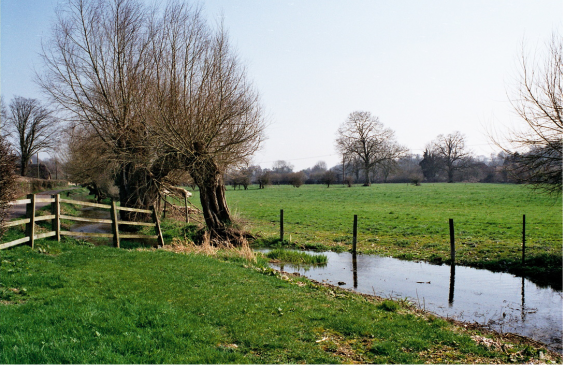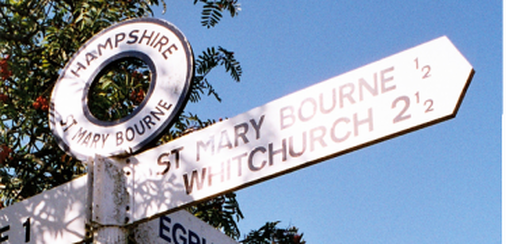The Parish

The Parish of St Mary Bourne includes the larger village of that name (population around 1,000), the smaller village of Stoke (population around 170) and the hamlets of Binley, Dunley, Egbury, Link (Upper, Lower), Upper-, Middle- and Lower-Wyke (pronounced "Wick" or "Week") and Wadwick.
The old hamlet of Swampton, mentioned in Domesday, has now been incorporated into St Mary Bourne, as has the area known as Link, which stretches from the main village south to the viaduct. For much of the recorded past, our parent parish church was Hurstbourne Priors (2¼ miles south). St Peter's was probably originally built in late Anglo-Saxon times and has contained a very rare Baptismal Font since the 1150s – but became a ‘chapel of ease’, for the convenience of inhabitants of St Mary Bourne. Now this parish is joined with that of Woodcott, some 4 miles in the direction of Newbury, and back again with Hurstbourne Priors and its southern neighbour, Longparish.
There are rival theories why St Mary Bourne is so called. Its main feature is the seasonal stream, the Bourne Rivulet (a tributary of the River Test), and under the old calendar it may well have risen on St Mary's Day (2nd February). Another theory is that the church was originally dedicated to St Mary, with a holy spring near it – but why, then was it changed to St Peter?
The old hamlet of Swampton, mentioned in Domesday, has now been incorporated into St Mary Bourne, as has the area known as Link, which stretches from the main village south to the viaduct. For much of the recorded past, our parent parish church was Hurstbourne Priors (2¼ miles south). St Peter's was probably originally built in late Anglo-Saxon times and has contained a very rare Baptismal Font since the 1150s – but became a ‘chapel of ease’, for the convenience of inhabitants of St Mary Bourne. Now this parish is joined with that of Woodcott, some 4 miles in the direction of Newbury, and back again with Hurstbourne Priors and its southern neighbour, Longparish.
There are rival theories why St Mary Bourne is so called. Its main feature is the seasonal stream, the Bourne Rivulet (a tributary of the River Test), and under the old calendar it may well have risen on St Mary's Day (2nd February). Another theory is that the church was originally dedicated to St Mary, with a holy spring near it – but why, then was it changed to St Peter?
The Village
|
Most of us who live in St Mary Bourne believe that we are most fortunate to be in a 'real' village where newcomers are made very welcome by those who have been living here for a long time, and perhaps for generations.
St Peter's Church, the Village Centre and the local Primary School all play a leading part in encouraging a community spirit, giving a wide cross section of the village a sense of 'togetherness' - although it should not be suggested that we are without any of the problems which can make village life 'interesting'! But these are relatively minor. The cricket, football and bowling clubs make full use of the excellent Recreation Ground. We would urge everyone to visit our new Village Centre to see what a village with 1,200 adult inhabitants can fund, build and equip to a high standard in 4 years (1989-1993), and open without owing a penny. Visitors should also be impressed by the new bowling green which in 2005 allowed the old bowling green to be redeveloped for other sporting purposes.
The range of organisations and activities within the village give anyone who wishes an opportunity to participate or organise, or both. New activities such as the Short Mat Bowls and Badminton played in the Village Centre cater for all ages and are proving to be very popular. See more under CLUBS. We have a variety of public houses which are all very different but which between them will certainly cater for most tastes when it comes to drinking and dining out. The year 2001 saw the construction of a new Village Community Shop with Post Office adjacent to the Village Centre car park. The lake was the brainchild of Dr Evans, the local medical general practitioner for many years. He had the area excavated and ground water appeared, but in dry summers it can nearly disappear. The lake was gifted to the village, is looked after by the Parish Council and can be used for fishing, but only if you become a Club member. Model boats can be seen sailing the waters but they are not nearly as graceful as the birds. For those who have not been here before, do walk up the hill from the rear of the Recreation Ground to look down on the village, or take a stroll along the village street or Bourne Rivulet, which this season (2019) remained dry due to lack of rain during last autumn, winter and spring, and perhaps visit our lovely old Church or one of the pubs. We are sure that you will be made very welcome by all the 'locals'. |






